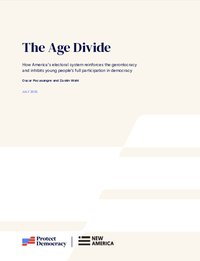The Age Divide: How America’s Electoral System Reinforces the Gerontocracy
Policy Paper

Aug. 18, 2025
This paper was originally published by Protect Democracy on August 18, 2025.
American political leadership is older today than at any other time in the nation’s history. Even internationally, the United States stands out for having one of the widest age divides between legislators and the people they represent. While age can bring valuable experience and institutional knowledge, the lack of young voices in politics means American democracy is missing out on the talents and ideas of younger generations. This underrepresentation also creates a harmful cycle: With few young people in office, younger Americans are more likely to feel alienated from the political system, leading to frustration, disillusionment, and ultimately lower levels of political participation.
In a new Protect Democracy and New America paper, Oscar Pocasangre and Dustin Wahl explore these age divides in the United States and the role that the two-party system plays in perpetuating gaps in representation and political participation. The paper’s key takeaways include:
- The U.S. has the widest age representation divide between legislators and the median population than in other OECD countries.
- Young people vote, donate to campaigns, and run for office at lower rates, not out of apathy, but because they see themselves and their priorities represented less in politics and have fewer financial resources.
- The American winner-take-all electoral system forces young voters disaffected with the existing parties to choose candidates they dislike the least or to abstain from voting. It also makes it unfeasible for young people to organize and create new parties to advance their policy interests.
- Countries with proportional electoral systems see higher levels of youth representation and participation in politics. Compared to winner-take-all systems, proportional systems provide more opportunities for young people to run for office and for parties to invest in younger candidates.
Achieving proportional representation in the U.S. is a challenging task, but young people—already more supportive of alternative electoral systems—can lead the way and become a powerful constituency for electoral reform that delivers a more inclusive and responsive political system for all.